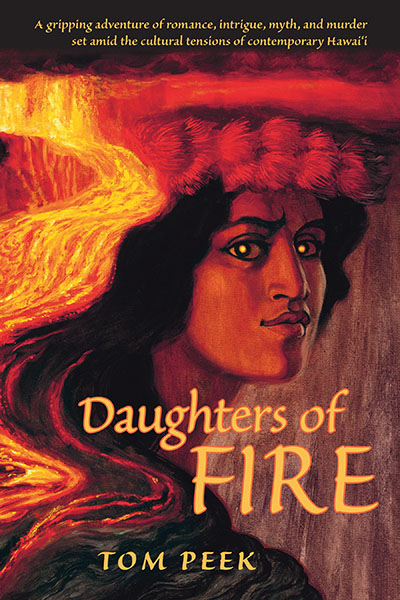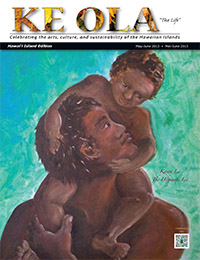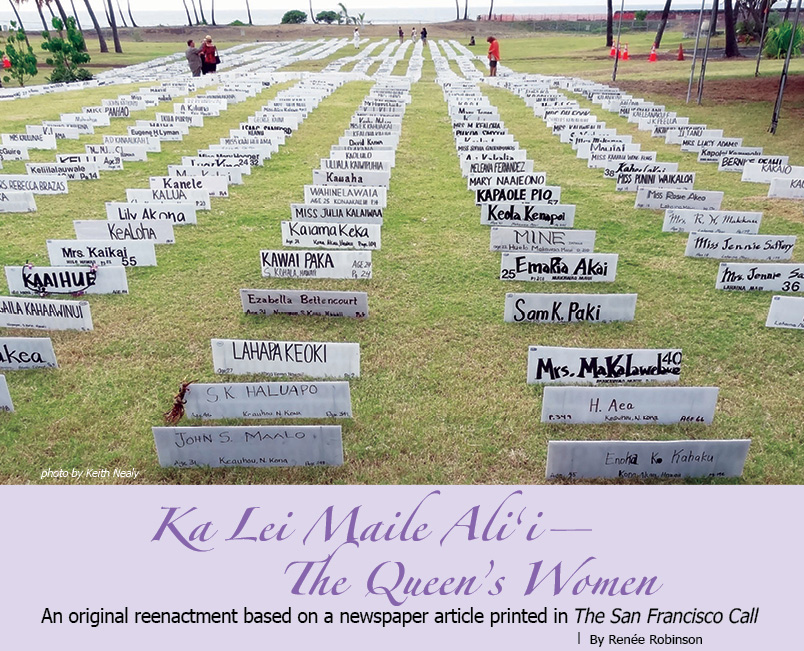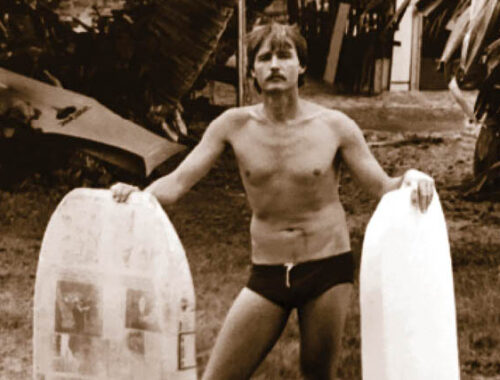Ka Puana: Maile Connects with Her Ancestors
 An excerpt used with permission of the publisher KoaBooks.com
An excerpt used with permission of the publisher KoaBooks.com
Late that night…A gecko straddled the limb of a guava tree above the freshwater pond, alert to the rustle of Maile coming down the jungle path. Passing beneath the lizard’s perch, she stood at the edge of the pond. Maile stared at the mirror of dazzling stars and recalled that in glassy pools like this, young Hawaiian navigators had studied the positions of the stellar beacons they used to find their way back and forth across the Pacific. If only these stars could guide her through the stormy seas she felt herself foundering in.
A gentle breeze ruffled her pareu and tugged the delicate petals of the plumeria lei draped over her bare shoulders, moon-white blossoms plucked that night from trees in her yard. Beneath the lei was an ancient talisman, a lizard of bone on a sennit cord. This was only the second time it lay upon Maile’s chest. Eighteen years earlier, on the sixteenth birthday of the woman-child, her mother had placed it there. “This is not jewelry,” she had cautioned her daughter. “It carries the mana of generations of women in our family, including that lodged in the bone of a seer in the line. It will give you protection when you need it, and insight if you have the will to accept it.” Maile had recognized its power immediately, for it tingled that day upon her breast. Too powerful for a girl uncertain of her identity, a child not yet proud of her Polynesian blood. She might just as easily have been given a jade pendant, ancestral symbol of her Chinese heritage. But at that time, either would have been too potent for the young Maile. She had placed the bone talisman in a fine wooden box and tucked it away in her chest of private things.
Some years later her mother and father gave her a gold necklace and a “Hawaiian heirloom” gold bracelet engraved with island foliage and her name, a high-priced, modern status symbol to island women of all ethnicities. These Maile wore with pride. Over the years she received more heirloom bracelets from her family, including those that had been worn by her mother. Engraved in the stylized characters of Victorian England, the gold bands also held personal meanings, and for some invoked sentiment for Hawai‘i’s last monarch, Queen Lili‘uokalani, who’d been given one by Queen Victoria. Before coming to the pool, Maile had removed the bracelets and replaced the necklace with the bone talisman.
In the distant windows of a condominium built above the ponds, blue television screens flickered, and the black hulk of Mauna Kea loomed over the twinkling sugar towns far up the Hamakua coast. The surf roared, its frothy combers pummeling the jagged coastline just beyond the ponds.
Maile looked up at the spray of sparkling stars spread across the sky—the Milky Way, kua mo‘o, the backbone of the lizard. She began a chant stored in her memory since childhood:

O na ‘aumakua wahine me na kupuna wahine ali‘i,
Na ‘aumakua wahine i ka hikina, a i kaulana a ka la,
Na wahine i ka lewa lani, i ka lewa nu‘u …
O female ‘aumakua and ancestral chiefesses,
Female ‘aumakua at the rising and setting places of the sun,
Female spirits in the firmaments of the heavens and of the clouds …
Maile’s eyes gleamed in the starlight, and her voice sank into a rich tremolo not unlike the reverberation of the distant waves.
… Owau nei o Kiha ka pua keia i ke a. Homai i mana.
This is I, Kiha, your descendant in this world of the living. Give me mana.
Maile peered into the pool and pondered the great serpent of stars moving across it. She lifted the lei from her shoulders and set it on a prominent lava rock next to the pool. Then she loosened the fabric knot beneath her arm and dropped the pareu onto the grass. The breeze felt balmy against her nakedness, and the skin beneath the talisman tingled. Maile stepped down the bank and slipped into the brisk water. Only her face and great spray of hair were visible against its dark surface.
Her ancestral line was the mo‘o, the lizard, many of whom, according to legend, lived in pools like this. She discovered at an early age that she would lose her center—become distracted or confused—if she did not get into the sea, the pools, or the mountain streams at least once every few days. Here was communion with her ancestral spirits. But she need not be in water to receive their guidance. They often visited her home or office in the form of geckos, little striped lizards who perched on window sills or hung from her lanai beams. Their silent presence or a soft chortle were taken as signs of affirmation, but a cackle meant it was time to pay attention, and when on rare occasions they leaped onto her shoulders or scampered directly across her path, she knew something was seriously amiss.
Maile’s grandmother taught her to ignore the bad reputation mo‘o had among some Hawaiians, islanders who accepted ancient ali‘i legends that portrayed lizards as evil or cruel. Those stories had been passed down by royal descendants with an historical ax to grind—many of her mo‘o clan had resisted the Tahitian takeover of the islands and the dark priest Pa‘ao.
The cold water helped Maile focus her mind—on Aka and Kimo’s disappearance; on the missing photographer, Jimmy; and on the grisly murder on the molten flank of Kilauea. With intense concentration and traditional prayer, Maile requested assistance from her ancestors. She stayed in the pool for many minutes, treading water so gently that she remained almost still. The stars of kua mo‘o blurred into a hazy vision, and the roar of the sea spoke to her as ancestral voices—distinct, loving, and wise. The inner voice of her na‘au translated the messages. At last, as her body began to tremble, she knew what she must do.
Maile pulled herself up onto the bank. She lay for a moment in the cool grass, naked to the elements, then knelt beside the glassy surface of the pond. She gathered up the garland of plumeria from the rock and for a moment buried her nose in its sweet blossoms. She gently pushed the lei out onto the water, an offering of gratitude for the strength and guidance she had just received.
This book is is available at: Volcano Art Center Gift Shop, Basically Books, Kona Stories, and other book and gift shops islandwide. DaughtersOfFire.com


